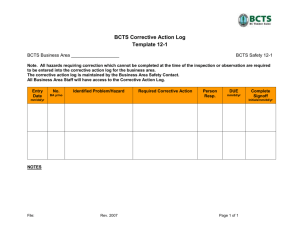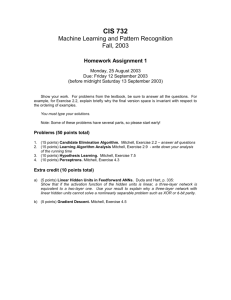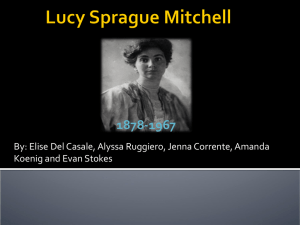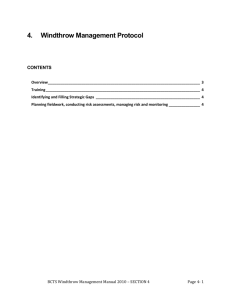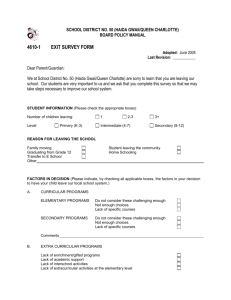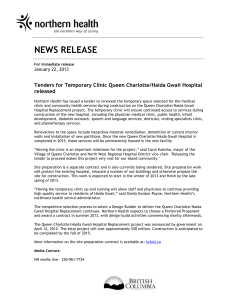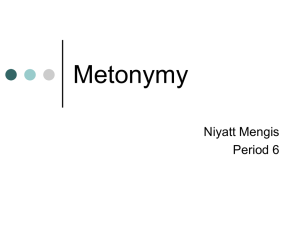Sec 3 Windthrow Trends Section Apr 30
advertisement
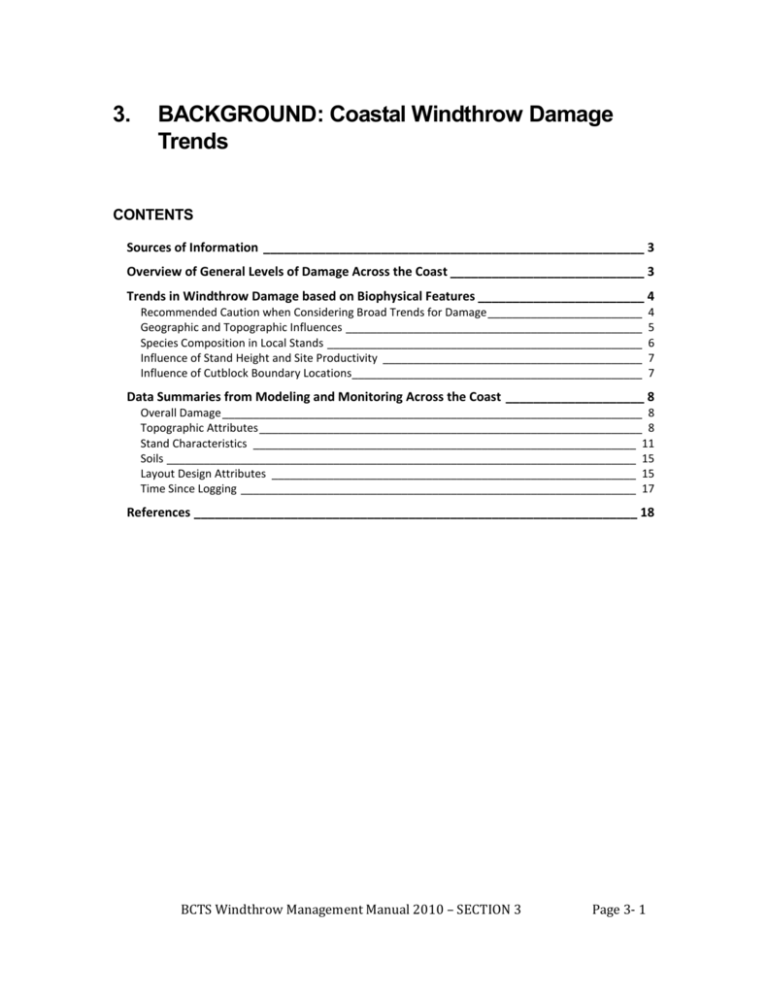
3. BACKGROUND: Coastal Windthrow Damage Trends CONTENTS Sources of Information _______________________________________________________ 3 Overview of General Levels of Damage Across the Coast ____________________________ 3 Trends in Windthrow Damage based on Biophysical Features ________________________ 4 Recommended Caution when Considering Broad Trends for Damage _________________________ Geographic and Topographic Influences ________________________________________________ Species Composition in Local Stands ___________________________________________________ Influence of Stand Height and Site Productivity __________________________________________ Influence of Cutblock Boundary Locations_______________________________________________ 4 5 6 7 7 Data Summaries from Modeling and Monitoring Across the Coast ____________________ 8 Overall Damage ____________________________________________________________________ 8 Topographic Attributes ______________________________________________________________ 8 Stand Characteristics ______________________________________________________________ 11 Soils ____________________________________________________________________________ 15 Layout Design Attributes ___________________________________________________________ 15 Time Since Logging ________________________________________________________________ 17 References ________________________________________________________________ 18 BCTS Windthrow Management Manual 2010 – SECTION 3 Page 3- 1 BCTS Windthrow Management Manual 2010 – SECTION 3 Page 3- 2 FOR TABULAR SUMMARIES – See the end of this section Sources of Information The following section summarizes data from several key sources. Most information comes from three modeling projects for BCTS (Mitchell and Lanquaye-Opoku 2009). Information is also included from modeling projects completed for Weyerhaeuser in Haida Gwaii (Mitchell and Lanquaye 2004), in West Island Division (Mitchell 2003) and in North Island Division (Lanquaye 2003). In addition, information is drawn from extensive multi-year field monitoring of windthrow in variable retention cutblocks throughout Western Forest Products tenures on Vancouver Island, the Coastal mainland and Haida Gwaii (Rollerson et al. 2009). Overview of General Levels of Damage across the Coast1 Rollerson et al. (2009) compared windthrow damage on cutblock edges across all Western Forest Products (WFP) tenures in coastal BC, including Gold River, Holberg, Jeune Landing, Mid Vancouver Island, Nootka Sound, Port Alberni (West Island), Port McNeil, Haida Gwaii, South Island and Stillwater (Powell River). They found 6-18%2 of all stems to be damaged (on average) in 0.1 ha segments that were 25 m into the edge. This proportion was highly variable ranging up to 90% for such segments. Rollerson’s data was averaged across all edge orientations. Mitchell et al. (2003, 2009) and Lanquaye (2003) reported on the proportion of segments (25m by 25m) with more than 20% canopy loss in more than 30% of the area of the segment. Using these data, windthrow as a general damage concern can be compared across various geographic areas on the coast (Table 1). Haida Gwaii generally experiences the most windthrow damage on the coast, with significantly higher levels than those experienced on the South Coast or Vancouver Island. Southwestern Vancouver Island (Port Alberni Operations Unit) ranks second in the level of damage, although it was significantly lower than Haida Gwaii. Elevated levels of damage in this area are likely influenced by the exposure of stands on the Coastal plain near the West Coast to intense Pacific storms, and the exposure of dense second growth stands to winds off the Alberni Inlet. Trends found here may be useful for other Coastal plain stands further south, or at the northern end of Vancouver Island. Northeastern Vancouver Island (Campbell River to Woss) has lower (moderate) levels of damage, likely because a mix of ridges and valleys modifies and dampens impacts of storms off the Pacific. 1 NOTE: Geographic references here to Haida Gwaii, Port Alberni, Squamish, and Chilliwack are for the BCTS operational units. Trends for some of these areas may apply to other similar areas on the Coast. For example, some of the information for Squamish and Chilliwack may be equally valid in inland portions of the Sunshine Coast. 2 The low average (6%) was for Southern Vancouver Island, while the high average was for Jeune Landing – with Haida Gwaii at 13%, Port Alberni and Stillwater at 11%, Holberg at 15%, and Port McNeil at 8%. Note: this information is based on a proportion of stems measured on the ground – therefore a large number of small stems can provide a large value. BCTS Windthrow Management Manual 2010 – SECTION 3 Page 3- 3 Chilliwack and Squamish have the lowest levels of damage on the coast reflecting their complex terrain, and distance from the open Pacific - although the Strait of Georgia, Howe Sound and the Fraser Valley all experience periodic high winds. Table 1. Windthrow damage as experienced by various geographic areas on the coast. Damage is expressed by the number of edge segments (25 x 25m) that have experienced a certain level of damage3. Geographic Area Proportion of edge segments with (x% canopy loss) and (y% of the segment area) % of segments % segments % segments with 20,30 with 50,90 with 50,100 Total # of segments sampled 1. Haida Gwaii 27% 5% 5,000 2. West Van. Island 19% 3. North Van. Island 12% 7% 6,700 4. Sunshine Coast (Stillwater) 10% 2% 14,800 5. Chilliwack 7% 0.3% 6000 6. Squamish 5% 1% 6000 4% 22,000 Trends in Windthrow Damage based on Biophysical Features There are distinct differences between BCTS geographic areas across the coast, both in terms of the magnitude of damage experienced with various biophysical variables, and some subtle differences in how the variables themselves influence windthrow locally. Note that these trends were based on damage experienced on existing edges, so they reflect susceptibility of those areas favoured for harvesting in the past. Recommended Caution when Considering Broad Trends for Damage The variation in windthrow damage experienced in these regions of the coast, summarized by various biophysical features, illustrates well the complexity of local windthrow hazard and likelihood assessments. The local wind regime and topographic exposure generally are the driving factors for wind damage. However, the influence of some factors often overwhelms or masks the influence of other factors, and these may not always be anticipated. It is useful to map probability of windthrow damage broadly across a region so the most troublesome areas are evident (i.e. those areas where windthrow should drive prescriptions and layout rather than those areas where it is an important factor, but not a prescription driver). 3 See references above for sources of data. BCTS Windthrow Management Manual 2010 – SECTION 3 Page 3- 4 The information and data that follows should be viewed with caution when drawing conclusions for specific geographic locations. These data are averaged over large areas. As well, different studies quantify damage differently. Broad geographic trends regarding hazard and windthrow likelihood are useful, but should not be applied to individual stands without taking local evidence into account. Furthermore, while wind regime and topographic exposure drive windthrow hazard, local stand and soil conditions may increase or reduce tree stability. In the summary below, we report the association of individual factors with windthrow outcomes, even though these outcomes always reflect the interaction of multiple factors. For example, some site and stand factors are associated with marked increases in damage, and yet only 30-40% of cutblock edges with these high susceptibility conditions were actually damaged. It is likely that in the other 60-70% of locations, other factors compensated, leading to greater stability than the single factor alone would indicate. It is critical to make local observations of past windthrow near newly proposed cutblocks to draw conclusions regarding local influences on windthrow and to calibrate assessment of hazard and risk accordingly. Geographic and Topographic Influences4 Haida Gwaii experiences more windthrow damage than the two southern BCTS business areas. This is due to an increased consistent exposure to frequent, more extreme wind events in this geographic location. A significant proportion of area is uniform and relatively flat providing little shelter the winds that come off Hecate Strait or the Pacific. Inland areas with highly complex topography (such as West Vancouver Island, North Vancouver Island, Chilliwack or Squamish) generally show less consistent patterns with topography over the whole area, than does Haida Gwaii. Topographic influences, while important, must be examined within the context of geographic location, and at finer scales. Basically for windthrow, geographic exposure to high winds takes precedence over topographic influences. Note that in the Chilliwack operating area, and possibly in the vicinity of Squamish, major valleys are exposed to summer inflows and winter outflows, likely causing localized damage that is not evident in the overall trends shown in the data generated by Mitchell and Lanquaye-Opoku (2009). Similar trends may be found in large coastal inlets on the Mid and North Coast. In Haida Gwaii some topographic variables show clearer trends in terms of damage than in other areas (West & North Vancouver Island, Chilliwack and Squamish). Yet, it is not quite that simple. In Haida Gwaii, significantly higher precipitation inputs and less rugged terrain subdues the gradient of decreasing site productivity with elevation to a degree. This means that relatively taller, less open stands on midto-upper slopes in Haida Gwaii possibly contribute to higher levels of damage when exposed than those in North and West Vancouver Island, Chilliwack and Squamish. Different rooting environments in Haida Gwaii also likely play a role. Generally speaking, windthrow increases in all areas with increasing elevation. Significant sheltering in lower elevations is only felt in Haida Gwaii below 100 m, 4 For Sources of data – see the data summaries at the end of this section. BCTS Windthrow Management Manual 2010 – SECTION 3 Page 3- 5 where it is evident in Chilliwack below 500 m and in Squamish below 1000 m. However, in West Vancouver Island, damage was found to be highest at low elevations, reflecting the higher annual (and peak) windspeeds on the Coastal Plains close to sea level along the West Coast (Mitchell 2003). In Squamish, Chilliwack, and North / West Vancouver Island no particular windthrow trends were attributed to slope steepness, while a clear trend is evident in Haida Gwaii with significantly more damage on slopes over 20%. Again this likely reflects the differences in terrain complexity, stand types and rooting environments. In all areas more windthrow was noted with cublocks located on north rather than south hillslope aspects, being somewhat counter-intuitive, considering that damaging winds are typically from the south. However, it is presumed that on south slopes stands are more acclimated, having developed under the influence of strong winds. This is a topographic aspect effect, and should not be confused with the orientation of cutblock boundary edges. Species Composition in Local Stands5 On West and North Vancouver Island and Squamish trends for species susceptibility follow those found across the coast, with more damage generally in hemlock and balsam (Abies amabilis)5 stands and less in cedar (western red and yellow) and Douglas-fir6. Haida Gwaii also follows these trends, but there are no amabilis fir stands. In Chilliwack, Douglas-fir stands appear slightly more vulnerable than hemlock and amabalis/subalpine fir (although the difference is not large). Likely this difference is due to the structure of the stands rather than the species composition. Chilliwack has a dominance of second growth Douglas-fir, which is usually more dense, tall and slender, especially on the productive mid-lower slopes where many of these stands are found. In West Vancouver Island, Douglas-fir and yellow-cedar dominated stands suffered the least windthrow damage compared to those dominated by other species. Hemlock stands had the highest loss. Stands dominated by alder, Douglas-fir, Sitka spruce and yellow-cedar were less frequently damaged than those dominated by western redcedar, amabilis fir and hemlock. Western redcedar in West Island may show more damage than in other areas, since it dominates stand composition on the Coastal plain, which is exposed to much higher winds than other portions of the area. In Northern Vancouver Island stands dominated by western redcedar were less frequently damaged in the first 25 m of an edge than amabilis fir leading stands. However, damage penetration to 50 m was more common in hemlock stands than stands of other species. On vulnerable edges in Northern Vancouver Island: amabilis fir leading stands had the highest percent canopy loss; hemlock stands had medium canopy loss; and western redcedar dominated stands had the lowest amount of canopy loss. For comparison, Rollerson et al. (2009) found cutblock edges to have more total wind damage when dominated by hemlock, red alder and amabilis fir, while edges 5 For Sources of data – see the data summaries at the end of this section. 6 Excluding Haida Gwaii where this species is not found. BCTS Windthrow Management Manual 2010 – SECTION 3 Page 3- 6 dominated by Douglas-fir, western redcedar, yellow-cedar and shore pine had lower levels of damage. Rollerson found highly variable, but generally higher levels of edge damage associated with Sitka spruce. Influence of Stand Height and Site Productivity7 Across all areas the most vulnerable stands are relatively tall (i.e., about 35 m in height), with much less damage in shorter stands (i.e., closer to 15 m). However, the tallest stands in a given area typically had a little less damage than stands of average height, perhaps because they are older, less dense and slender, and may be in more sheltered geographic positions. The slenderness coefficient (height to diameter ratio) is strongly correlated with windthrow damage. A value of 60 appears to be a good threshold with much more damage for height:diameter ratios of greater than 60 and significantly less damage as values drop below 60. More damage was found on richer sites (SI50> 20) in Haida Gwaii, and on Vancouver Island. However, moderate site indices in Chilliwack had greater damage, while in Squamish site indices below 20 showed increased damage. In these locations, site index declines rapidly with elevation and the higher elevation stands are exposed to higher wind speeds. Influence of Cutblock Boundary Locations6 Layout decisions have a clear influence on windthrow. In all areas (regardless of aspect) southern-exposed boundary orientations experience much more damage since they are the most exposed to that southerly winds (SE-SW) that accompany winter storms . Fetch is the term used to describe the width of the opening in the direction of wind. Openings with larger fetch have increased damage. Boundary projections that are exposed to several wind directions have greater damage. Narrower (<20 m) internal retention strips experience more damage, as do small retention patches and dispersed trees. Boundaries located on the slope break into gullies (compared to those set back in upland terrain). 7 For Sources of data – see the data summaries at the end of this section. BCTS Windthrow Management Manual 2010 – SECTION 3 Page 3- 7 Data Summaries from Modeling and Monitoring Across the Coast Overall Damage DATA - BASED ON # of SEGMENTS (25 m by 25 m) DAMAGED – with more than 20% of canopy loss over more than 30% of the area of the segment. AVERAGE - 27% damaged (over 5000 segments) (5% damaged with 50% canopy loss over 90% of area in segment) AVERAGE – 6.6 % damaged (over 6000 segments) (0.3% damaged with 50% canopy loss over 90% of area in segment) AVERAGE – 5.4 % damaged (over 6000 segments) (1% damaged with 50% canopy loss over 90% of area in segment) AVERAGE 19% damaged (over 22,000 segments) A total of 20% of all boundary segments had levels of damage detectable from aerial photographs. However, only 4% of segments had more than 100% area loss and 50% of canopy loss. AVERAGE 12% damaged (over 6715 segments) (7 % damaged with 50% canopy loss over 90% of area in segment, ) SOURCE BCTS Haida Gwaii (Mitchell and LanquayeOpoku 2009) BCTS Chilliwack (Mitchell and Lanquaye-Opoku 2009) BCTS Squamish (Mitchell and Lanquaye-Opoku 2009) Weyerhaeuser, West Island (Mitchell 2003) Weyerhaeuser, North Island (Lanquaye 2003) Topographic Attributes Slope Position and Features (ROLLERSON ET AL. 2009) trends across all WFP tenures: Exposed positions such as ridge crests and upper slopes experience more damage – confirms somewhat Mitchell’s elevational data. Mid slopes tend to have lower damage. Valley floor positions had moderate damage rates. BCTS Windthrow Management Manual 2010 – SECTION 3 Page 3- 8 Damage on internal groups and clusters, was found to be less in valley floor and lower slope locations and relatively high on upper slopes and ridges. Topex Score at 1 km Higher numbers indicate less exposed and lower numbers are more exposed (can be significantly negative in value). Note: these Topex scores are regardless of the general exposure direction. DATA - BASED ON # of SEGMENTS (25 m by 25 m) DAMAGED – with more than 20% of canopy loss over more than 30% of the area of the segment. SOURCE < 100 = > 30% damaged BCTS Haida Gwaii (Mitchell and LanquayeOpoku 2009) NO STRONG PATTERN BCTS Chilliwack (Mitchell and Lanquaye-Opoku 2009) Reflects the complex pattern of extreme wind with geographic position and terrain. NO STRONG PATTERN Reflects the complex pattern of extreme wind with geographic position and terrain. BCTS Squamish (Mitchell and Lanquaye-Opoku 2009) Did not report on Topex 1000, for Topex 3000 values less than 125 had approximately 20% damage. Weyerhaeuser West Island (Mitchell 2003) Topex damage levels were not reported on, however Topex 1K was found to have a correlation coefficient of 0.7. Weyerhaeuser, North Island (Lanquaye 2003) BCTS Windthrow Management Manual 2010 – SECTION 3 Page 3- 9 Elevation NOTE: Elevation strongly influences local relative windspeeds, but it becomes a much more variable predictor of damage in complex terrain. DATA - BASED ON # of SEGMENTS (25 m by 25 m) DAMAGED – with more than 20% of canopy loss over more than 30% of the area of the segment. SOURCE MORE DAMAGE higher up (300-500 m) – 35 to 50% damaged LESS lower down at 100 m – less than 25% damaged NOTE – Mitchell found NO STRONG CORRELATION – on Weyerhaeuser lands - Slightly more damage from 200-600 m. Likely because the area included more younger second growth stands and flat terrain on the Hecate lowlands (with little sheltering effect). Less below 500 m - 4% More above 500 m – but erratic (between 5% and 8.5% and it goes up and down several times as elevation increases) LESS LOWER (below 1000m) - <5% MORE HIGHER (above 1000m) – 8-23% BCTS Squamish (Mitchell and Lanquaye-Opoku 2009) DAMAGE BY ELEVATION VARIED LITTLE – varying between 21 and 22% Weyerhaeuser West Island (Mitchell 2003) Slightly higher at low and high elevations (200 and 1000m), Intermediate at 600 m No information for North Island BCTS Windthrow Management Manual 2010 – SECTION 3 BCTS Haida Gwaii (Mitchell and LanquayeOpoku 2009) BCTS Chilliwack (Mitchell and Lanquaye-Opoku 2009) Weyerhaeuser, North Island (Lanquaye 2003) Page 3- 10 % Slope DATA - BASED ON # of SEGMENTS (25 m by 25 m) DAMAGED – with more than 20% of canopy loss over more than 30% of the area of the segment. < 20% = < 30% damaged > 20% = > 30% damaged up to over 40% NO PARTICULAR PATTERN FROM SLOPE Presumably due to the complexity of the terrain NO PARTICULAR PATTERN FROM SLOPE Presumably due to the complexity of the terrain No information on % slope for West Island No information on % slope for North Island SOURCE BCTS Haida Gwaii (Mitchell and LanquayeOpoku 2009) BCTS Chilliwack (Mitchell and Lanquaye-Opoku 2009) BCTS Squamish (Mitchell and Lanquaye-Opoku 2009) Weyerhaeuser West Island (Mitchell 2003) Weyerhaeuser, North Island (Lanquaye 2003) Aspect Generally less on South than North Aspects – across all three areas. Likely stands on south aspects are slightly more acclimatized to southerly winds. Stand Characteristics Less important than topographic attributes and boundary orientation across all areas. Crown closure, stand heights and slenderness all have increased damage as they increase – up to a point then decline. This reflects increasing damage in dense, slender, tall stands. Vulnerability decreases where second growth becomes very dense and stems lean back into the stand and stabilize (rather than falling through). Older stands with tall emergent trees have less damage than stands with uniformly dense overstories. HAIDA GWAII – BCTS operations are dominated by mature and older stands, except for the Hecate Lowlands. CHILLIWACK – BCTS operations are dominated by stands less than 200 years old. SQUAMISH – BCTS operations are dominated by stands less than 200 years old, with similar but with slightly more old growth stands than in Chilliwack. BCTS Windthrow Management Manual 2010 – SECTION 3 Page 3- 11 Species Composition DATA - BASED ON # of SEGMENTS (25 m by 25 m) DAMAGED – with more than 20% of canopy loss over more than 30% of the area of the segment. Hemlock stands – more frequent at 35% (key is hemlock up to 230 years for vulnerability, especially when > 30 m tall) Sitka spruce – 27% Western redcedar – 23% (at 110 to 210 years – as much damage as older stands) NOTE MITCHELL (2004) FOUND NO STRONG SPECIES CORRELATION ON WEYERHAESER LANDS presumably due to the very strong influence of the dense even aged second growth stand structures where all species become vulnerable. DOUGLAS-FIR stands – more frequent – but still only 8% Hemlock and amabalis fir – 6% NOTE: Many second growth stands here are dominated by Douglas-fir. Stands can be dense, tall, slender and therefore potentially vulnerable. Basically here Douglas-fir stands of 130-170 years are most frequently damaged while hemlock stands between 50 and 110 years are most frequently damaged. Both these stand types are more frequently damaged on sites with moderate fertility. Amabalis fir, hemlock and Sitka spruce stands – most frequently damaged (7-14% of segments) Douglas-fir stands – least damaged (2% of segments) Stands dominated by alder, Douglas-fir, Sitka spruce and yellow-cedar were less frequently damaged than those dominated by western redcedar, amabilis fir and hemlock. Douglas-fir stands were damaged less than other stands, however these stands were typically located in inland areas with lower mean wind speeds and greater topographic shelter. Western redcedar stands were less damaged than hemlock stands. Amabilis fir stands have been found to be more vulnerable than hemlock and western redcedar in other coastal studies, but this was not found in WI. BCTS Windthrow Management Manual 2010 – SECTION 3 SOURCE BCTS Haida Gwaii (Mitchell and LanquayeOpoku 2009) BCTS Chilliwack (Mitchell and Lanquaye-Opoku 2009) BCTS Squamish (Mitchell and Lanquaye-Opoku 2009) Weyerhaeuser West Island (Mitchell 2003) Page 3- 12 DATA - BASED ON # of SEGMENTS (25 m by 25 m) DAMAGED – with more than 20% of canopy loss over more than 30% of the area of the segment. Hemlock dominated stands were more frequently damaged than stands dominated by western redcedar in both the 25 and 50 m buffers. Western redcedar was the least frequently damaged among all species. The differential between hemlock and western redcedar was even more pronounced in the 50 m buffer indicating that hemlock stands are more vulnerable to more deeply penetrating damage. SOURCE Weyerhaeuser, North Island (Lanquaye 2003) Height (ROLLERSON ET AL. 2009) trends across all WFP tenures: Confirmed the general increase in damage with height, as below. DATA - BASED ON # of SEGMENTS (25 m by 25 m) DAMAGED – with more than 20% of canopy loss over more than 30% of the area of the segment. SOURCE Above 30 m - 30% of segments show damage with less below that (15% at 15 m) BCTS Haida Gwaii (Mitchell and LanquayeOpoku 2009) Above 30 m – damage up to 10% Below 30 m – damage < 8% Stands in the 35 m height class had the most damage for all species. This presumably may be where height and slenderness make the stands most vulnerable due to density and crown closure. BCTS Chilliwack (Mitchell and Lanquaye-Opoku 2009) Most damage in 35 m ht class (6-7%) Slightly less damage at 15-25 m (4-6%) Less damage at 45 m (4-5%) No information from West Island as age and height data were incomplete in the forest cover database Not reported on for North Island BCTS Windthrow Management Manual 2010 – SECTION 3 BCTS Squamish (Mitchell and Lanquaye-Opoku 2009) Weyerhaeuser West Island (Mitchell 2003) Weyerhaeuser, North Island (Lanquaye 2003) Page 3- 13 Slenderness DATA - BASED ON # of SEGMENTS (25 m by 25 m) DAMAGED– with more than 20% of canopy loss over more than 30% of the area of the segment. > 60 – up to 33% (may be less when > 70 with very dense stands) < 60 –tends to be < 20% > 60 – damage up to 10% < 60 - < 6% damaged More damage when > 60 – (5-10%) Less damage when < 45 (0-4%) No information from West Island Not reported on for North Island SOURCE BCTS Haida Gwaii (Mitchell and LanquayeOpoku 2009) BCTS Chilliwack (Mitchell and Lanquaye-Opoku 2009) BCTS Squamish (Mitchell and Lanquaye-Opoku 2009) Weyerhaeuser West Island (Mitchell 2003) Weyerhaeuser, North Island (Lanquaye 2003) Site Index DATA - BASED ON # of SEGMENTS (25 m by 25 m) DAMAGED– with more than 20% of canopy loss over more than 30% of the area of the segment. Above SI 20 - >30% of segments show damage. Below SI20 – can still have 20-30% DOUG-FIR - Most damage at SI 17-25 – 8-10%. Above or below this there is less (6% or less). Topographic features – sheltering or speed-up of winds may be more important here for richer sites. SOURCE BCTS Haida Gwaii (Mitchell and LanquayeOpoku 2009) BCTS Chilliwack (Mitchell and Lanquaye-Opoku 2009) HEMLOCK – most damage at SI > 20 – up to 18%. Below this there is much less damage (4-6%) BCTS Windthrow Management Manual 2010 – SECTION 3 Page 3- 14 DATA - BASED ON # of SEGMENTS (25 m by 25 m) DAMAGED– with more than 20% of canopy loss over more than 30% of the area of the segment. Below SI 20 – MORE DAMAGE (6-10%) Above 20 – 2-4% This is likely because the low site index sites are at higher elevations and have greater wind exposure. No clear trends from West Island Not reported on for North Island SOURCE BCTS Squamish (Mitchell and Lanquaye-Opoku 2009) Weyerhaeuser West Island (Mitchell 2003) Weyerhaeuser, North Island (Lanquaye 12003) Soils Mitchell and Lanquaye-Opoku (2009) didn’t look specifically at surficial material in the 2009 modelling. Mitchell and Lanquaye (2004) on Haida Gwaii - looked at soils as an influence – found more windthrow on colluvial soils and organic soils and less on morainal, and especially fluvial soils. This factor had a lower influence on windthrow than stand factors, and a much less influence than topographic factors and boundary orientation. Drainage and fertility and their effects on stand height and stand density are probably more important that soil origin. Low fertility, poorly drained organic sites typically have lower damage than better drained higher fertility sites. Rollerson et al. 2009 across WFP Coastal tenures: Found the highest wind damage on poor-imperfectly drained mineral soils (gleysols or gleyed podzols) Also found a general but not consistent trend of more damage on deeper soils – presumably this is likely due to the presence of the denser, taller, more slender second growth stands generally found on such sites. Layout Design Attributes Boundary orientation (along with topographic attributes) more strongly influences windthrow than stand and soil characteristics – in all coastal studies. Exposed Boundary Orientation SOUTHERN FACING BOUNDARIES- Strong correlation to damage –are the worst in all Coastal studies. BCTS Windthrow Management Manual 2010 – SECTION 3 Page 3- 15 NORTHERN CUTBLOCK BOUNDARIES NEAR RIDGELINES – once the acclimated stand on the windward side of the ridge is removed, trees near the top on the lee side are exposed to large increases in wind loading and damage progresses down the lee slope, sometimes for considerable distances (Mitchell and Lanquaye 2004) Boundaries with multiple exposures to damaging winds typically have more damage, for example inward projections from boundaries, and boundaries on smaller reserve patches. DATA - BASED ON # of SEGMENTS (25 m by 25 m) DAMAGED– with more than 20% of canopy loss over more than 30% of the area of the segment. SOUTH TO WEST – 30-40% NORTH TO EAST – 15-22% NOTE – Mitchell found similar trend on Weyco lands in 2004 SOUTH – 12-14% NORTH – 2% EAST & WEST – 4-6% SOUTH – 9% NORTH – 2-3% EAST & WEST – 4-6% SOURCE BCTS Haida Gwaii (Mitchell and LanquayeOpoku 2009) BCTS Chilliwack (Mitchell and Lanquaye-Opoku 2009) BCTS Squamish (Mitchell and Lanquaye-Opoku 2009) Influence on external edges of cumulative fetch distance across the block. Rollerson et al. (2009) across WFP Coastal tenures: Found less than 10% windthrow with less than 100 m fetch. Damage rose to almost 20% at 200-300 m fetch No clear influence of internal retention patches, groups, and strips. Influence of external edges located along edges of gullies and stream escarpments. Rollerson et al. (2009) across WFP Coastal tenures: SUSTANTIALLY HIGHER damage found here. When boundaries are set back damage goes down significantly (by about 10%). Rollerson recommends setbacks of at least 10-15 m. Rollerson also cautions to increase setbacks and riparian reserve widths for steep gully headwalls at higher elevations where the potential for debris flow initiation and long landscape travel distances with significant downslope damage is high. BCTS Windthrow Management Manual 2010 – SECTION 3 Page 3- 16 Damage in internal patches (groups and clusters). Rollerson et al. (2009) across WFP Coastal tenures (averaged across the whole group or cluster): Ranged from 20% in Powell River up to 39% in QCI and mid-Vancouver Island. Slope position (see below) influenced damage rates Height influenced damage rates, as indicated below for Mitchell data. Species – generally least damage with yellow-cedar and Douglas-fir. Western redcedar had slightly higher levels of damage. Hemlock and amabalis fir showed the highest levels of damage. In Mitchell’s West Island Timberlands study, they found that internal patches had about 10% greater damage than edge segments, all other factors being the same. Scott and Mitchell (2005) found that damage to retained tree and patches declined with increasing internal retention. Damage in internal strips. Rollerson et al. (2009) across WFP Coastal tenures (averaged in the edge of the strip): Substantially higher than in external edges (31% compared to 24%). Less damage as strip width increases from 10-20m (close to 30%) to 30-50+ m (10-15%). Strips experience more damage from factors like stand height, species (as in groups and clusters) and location along gullies and stream escarpments. Note that even moderate setbacks of strips from the edges of gullies may cut damage rates in half. Found more damage in multi-storied stands than in uniform even aged stands – this is curious and may be due to exposure of numerous slender understory trees (while overstory trees may stay intact – making up few stems but most of the volume). Note: Rollerson calculated percentages based on number of stems. Time Since Logging Generally there was increasing damage with time since logging, but most activity occurs in the first 2 years. Beyond that: o HAIDA GWAII AND CHILLIWACK (Mitchell 2009) - No apparent pattern. o SQUAMISH – damage more frequent on blocks 3-7 years since logging – may just reflect changes in cutblock design or concentration of harvesting in more vulnerable locations. BCTS Windthrow Management Manual 2010 – SECTION 3 Page 3- 17 References Environment Canada. 2003. Canadian wind energy atlas. http://www.windatlas.ca/en/nav.php Last update : July 29, 2008 Contact: wind.atlas@ec.gc.ca Environment Canada. 1992. Marine weather hazards manual: a guide to local forecasts and conditions, 2nd edition. Gordon Soules Book Publishers Ltd in cooperation with Environment Canada and the Canada Communication Group – Publishing, Supply and Services Canada. Lanquaye, C. 1999. Empirical modelling of windthrow risk using geographic information systems, a thesis submitted in partial fulfillment of the requirement for the degree of master of science in forestry. UBC faculty of Forestry Library. Lanquaye, C. 2003. Empirical modelling of windthrow risk using geographic information systems, a thesis submitted in partial fulfillment of the requirement for the degree of master of science in forestry. UBC faculty of Forestry Library. Mitchell, S. 2003. Windthrow hazard mapping using GIS, Weyerhaeuser west island timberlands. Faculty of Forestry UBC. Prepared for Bill Beese, Weyerhaeuser BC Coastal Group, Nanimo BC. Mitchell, S., Lanquaye, N. 2004. Windthrow Hazard Mapping using GIS, Chilliwack, Weyerhaeuser Queen Charlotte Operations. Final Report prepared for Bill Beese, Weyerhaeuser Ltd Nanaimo - March 2004. Mitchell, S.J. and K. Zielke 2006. Windthrow prescription workshop (revised). Facilitators Guide. B.C. Min. For. Forest Practices Branch. Victoria, BC. Mitchell, S., Lanquaye-Opoku, N. 2009. Windthrow Hazard Mapping using GIS, Chilliwack, Queen Charlotte Islands, and Squamish Operation. Final Reports for BCTS - March 2009. Rollerson T.P., C.M. Peters, W.J. Beese. 2009. Variable retention windthrow monitoring project 2001-2009. FIA project for Western Forest Products Inc. Scott, R.E. and S.J. Mitchell (2005) Empirical modelling of windthrow risk in partially harvested stands using tree, neighbourhood and stand attributes. Forest Ecology and Management 218:193-209. BCTS Windthrow Management Manual 2010 – SECTION 3 Page 3- 18
